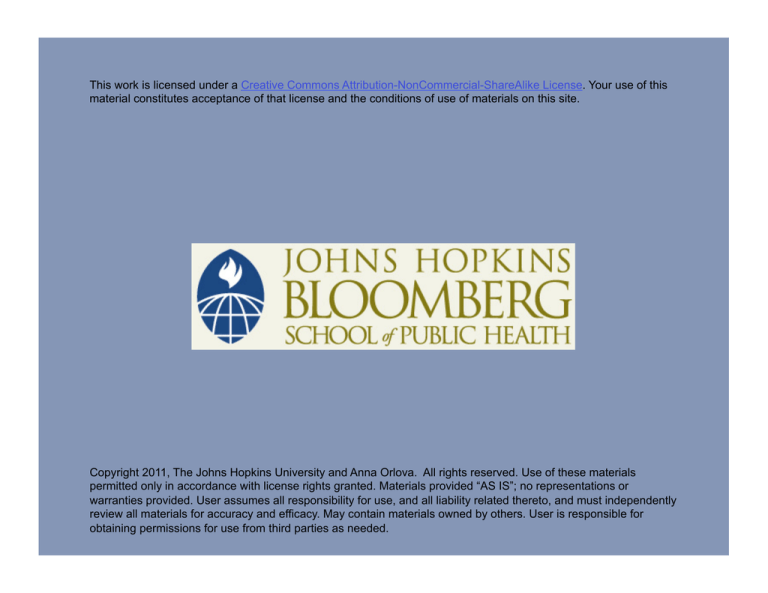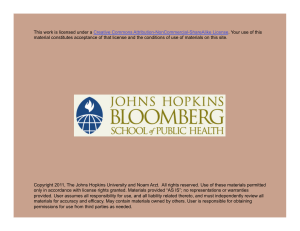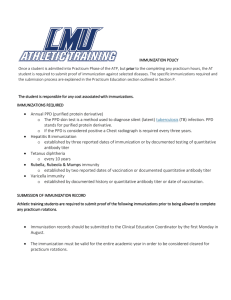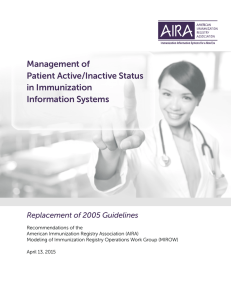
This work is licensed under a Creative Commons Attribution-NonCommercial-ShareAlike License. Your use of this
material constitutes acceptance of that license and the conditions of use of materials on this site.
Copyright 2011, The Johns Hopkins University and Anna Orlova. All rights reserved. Use of these materials
permitted only in accordance with license rights granted. Materials provided “AS IS”; no representations or
warranties provided. User assumes all responsibility for use, and all liability related thereto, and must independently
review all materials for accuracy and efficacy. May contain materials owned by others. User is responsible for
obtaining permissions for use from third parties as needed.
Towards Business Process Standards
Anna O. Orlova, PhD
Johns Hopkins Bloomberg School of Public Health
Health IT Standards Categories
Data standards
- E.g., vocabularies and
terminologies
Information content standards
- E.g., Reference
Information Models (RIMs)
Privacy and security standards
Functional standards and
business process standards
-
E.g., process/workflow
Other
- E.g., IT standards
Information exchange
standards
-
E.g., messaging standards
Identifiers standards
- E.g. National Provider
Identifier (NPI)
Source: (2006). Health Information Technology Standards Panel (HITSP). www.hitsp.org
3
Session Outline
Need for business process standards: example of immunizations
Business process definitions
Documenting business processes in public health
From business processes to systems requirements
-
-
Building a consensus on public health high-level business areas
Connecting business processes, functional requirements, and IT
solutions
4
Section A
Need for Business Process Standards: Example of
Immunizations
Example of Immunizations
“CDC is continuing the investment to assist states in
developing immunization information systems (registries)
—confidential, computerized information systems that
collect vaccination data within a geographic area. By
consolidating vaccination records from multiple healthcare providers, generating reminder and recall
notifications, and assessing clinic and vaccination
coverage, registries serve as key tools to increase and
sustain high vaccination coverage.
The Healthy People 2010 objective is to increase to 95%
the proportion of children aged <6 years who participate
(i.e., have two or more vaccinations recorded) in fully
operational, population-based immunization registries.”
Source: CDC. Immunization registry minimum functional standards.
http://www.cdc.gov/nip/registry/min-funct-stds2001.htm
6
Example of Immunization Registries
The goal of the Immunization Information System (Registry) is to
support the business processes for preventing spread of infectious
diseases by timely administering vaccination to the population
(children, adults) within a geographic area
To achieve this goal, the Immunization Registry system will support
the following functions:
-
Consolidate vaccination records from multiple health care
providers within jurisdiction
-
Generate reminder and recall notifications to providers and
patients
-
Assess clinic performance in vaccination coverage
7
EHR-S and IIS
8
Example of Immunizations
Immunization Information Systems (IIS) serve a jurisdiction by
providing a common repository for immunization information
IIS features (functions): EHR-S
-
-
-
Collect vaccination data by patient
Generate reminder of next immunizations due
Manage vaccine inventory (generate/manage vaccine orders,
order deliveries and recall notifications) within clinic
-
Assess vaccination coverage within clinic
9
Example of Immunizations
Immunization Information Systems (IIS) serve a jurisdiction by
providing a common repository for immunization information
IIS features (functions): IIS
-
-
-
-
-
Collect vaccination data by clinic, by jurisdiction
Generate reminder of next immunizations due
Consolidate vaccination records from multiple clinics
Manage vaccine inventory (generate/manage vaccine orders,
order deliveries and recall notifications) by jurisdiction
Assess vaccination coverage by clinic, by jurisdiction
10
EHR-S and EHR–IIS Features
11
Process Interoperability: Immunization Management
Source: AHIC Immunization & Response Mgmt Use Case Diagram: http://www.hhs.gov/healthit/usecases/respmgmt.html
12
EHR-S and EHR–IIS Features
13
IIS Interoperability Model
14
Process Interoperability: Immunization Management
Source: AHIC Immunization & Response Mgmt Use Case Diagram: http://www.hhs.gov/healthit/usecases/respmgmt.html
15
EHR-S and EHR–IIS Features
16
EHR-S and EHR–IIS Features
17
EHR-S and EHR–IIS Features
18
Health Department: Organizational Chart
19
Vision for 2014
Used with permission of Peter Elkin. All Rights Reserved.
20
RHIEs as NHIN Components
Construction of exchanges requires clear understanding of
interoperability in the context of business activities performed by
the users
-
-
-
Clinicians
Public health professionals
Patients
21
EHR-S: Public Health (PH) IS Features
22





